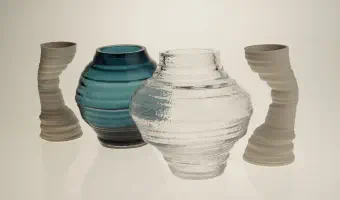
This work by the chinese designer Yisha Cai explores meteorological phenomena using digital data, conception and production tools. Especially interested in data visualization, Yisha Cai collected rain data through sensors and an arduino device. The data were then processed to generate a 3D model. The cylindrical clay tornado form was generated by code in a digital platform. It was subsequently printed in porcelain by a 3D ceramics printer. The accompanying glass globe form was shaped as a […]
This work by the chinese designer Yisha Cai explores meteorological phenomena using digital data, conception and production tools. Especially interested in data visualization, Yisha Cai collected rain data through sensors and an arduino device. The data were then processed to generate a 3D model. The cylindrical clay tornado form was generated by code in a digital platform. It was subsequently printed in porcelain by a 3D ceramics printer. The accompanying glass globe form was shaped as a positive form of the (imaginary) void created by the profile of the tornado. The blown glass globe form was produced in a unique 3D printed ceramics mould.
Sources:
Yisha Cai (2016) DUO TORNADO. (archived version) Laboratoire CCE (2019) “La céramique comme expérience”, Editions du CCE, Laboratoire de recherche de l’Ecole Nationale Supérieure d’art de Limoges, p. 104-111.
Added by: Anne-Laure Fréant.
Category:
Passive physical visualization
Tags:
weather, 3d printing, clay print, glass blowing, glass, ceramics, extruded 2d